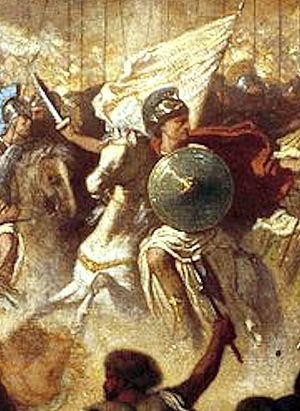Clearchus of Sparta facts for kids
Quick facts for kids
Clearchus
|
|
|---|---|

Clearchus of Sparta at the 401 BC Battle of Cunaxa, by Adrien Guignet.
|
|
| Native name |
Κλέαρχος
|
| Born | 450 BC Sparta |
| Died | 401 BC (aged 49) Babylon, Achaemenid Empire |
| Allegiance | Sparta Ten Thousand |
| Rank | Strategos |
| Battles/wars |
|
Clearchus (born around 450 BC – died 401 BC) was a famous Spartan general. He was also a mercenary, which means he was a soldier who fought for money for different countries or leaders. Clearchus is best known for leading a large group of Greek soldiers, called the Ten Thousand, in a big battle against the Persian king.
Contents
Who Was Clearchus?
Clearchus was born in Sparta, an ancient Greek city known for its strong army. He lived during a very important time in Greek history. This was when Sparta and Athens were fighting in a long and difficult war called the Peloponnesian War. Clearchus became a skilled military leader.
Early Life and Military Career
Clearchus started his military career around 412 BC. Sparta sent him with a fleet of ships to a place called the Hellespont. There, he took control of the city of Byzantium. He became a "proxenos" there, which was like a special representative for Sparta.
Clearchus soon made friends with Pharnabazus II. Pharnabazus was a Persian "satrap," or governor, of a nearby region. Clearchus and Pharnabazus decided to work together. They formed a military team against the Athenians.
Battles and Challenges
Clearchus led the Spartan army at the Battle of Cyzicus in 410 BC. However, his forces and their Persian allies were defeated by the Athenians. After this, Athens set up a naval blockade around Byzantium. This meant their ships stopped supplies from reaching the city.
Clearchus was given fifteen "triremes" (ancient warships) to break this blockade. He managed to reach Byzantium, but he lost three ships in a fight with the Athenian navy.
While Byzantium was under siege, Clearchus went to Persia. He hoped to get more money and support from Pharnabazus. But Clearchus was very strict with his soldiers. He rationed their food, which made him unpopular. While he was away, the city gates were opened to the Athenian army. Clearchus was later put on trial and fined for losing the city.
He was also present at the Battle of Arginusae. Another Spartan commander, Callicratidas, even said that Clearchus was the best person to take his place if he died.
Return to Sparta and Exile
After Athens was finally defeated, Clearchus went back to Sparta. He asked the "ephors," who were powerful Spartan leaders, for an army. He wanted to help Byzantium with its problems and protect Greek cities from attacks by the Thracians.
The ephors gave him the army. But they soon heard that the people of Byzantium thought Clearchus was acting like a "tyrant." A tyrant was a ruler who took power unfairly and used it harshly. The ephors sent a messenger to call him back.
Clearchus ignored the messenger and continued to Byzantium. Because of this, the ephors immediately declared him an "outlaw." This meant he was no longer protected by Spartan law.
Even as an outlaw, Clearchus successfully fought the Thracian tribes. This made the Greek cities he helped happy. He hoped his success would make the Spartan ephors forgive him. But they did not. After he took control of Byzantium, he removed its chief leaders and took wealth from some of the richest citizens. Sparta ordered him to leave, and when he refused, they sent an army to drive him out.
The Ten Thousand Expedition
Around this time, Cyrus the Younger heard about Clearchus and his strong Greek soldiers. Cyrus was a Persian prince who wanted to become the king of the Achaemenid Empire. He sent money to Clearchus, asking for his help to take the throne from his brother, King Artaxerxes II.
Clearchus agreed to help Cyrus. He knew he might have to face his fellow Spartans eventually since he was still an outlaw. So, he left the command of Byzantium to another leader.
Battle of Cunaxa and Aftermath
Clearchus became a main leader in Cyrus's army, which included about ten thousand Greek soldiers. This journey is known as the "expedition of the ten thousand." At the Battle of Cunaxa in 401 BC, Clearchus led the right side of Cyrus's army.
He was told to attack the middle of the enemy's army. Instead, he moved forward and pushed back the enemy's left side. This left Cyrus's own side open to attack. Cyrus charged into the enemy's center and was killed in the battle.
After Cyrus's death, Clearchus took charge of the Greek army. He led them on a long retreat back towards the Tigris river. During this retreat, he tried to negotiate with the Persians.
However, Clearchus and his group were invited to a banquet by Tissaphernes, a Persian general. At the banquet, they were arrested. Clearchus was sent to the royal court in Babylon. There, he was executed on the orders of Queen Stateira.
Images for kids
See also
 In Spanish: Clearco para niños
In Spanish: Clearco para niños


